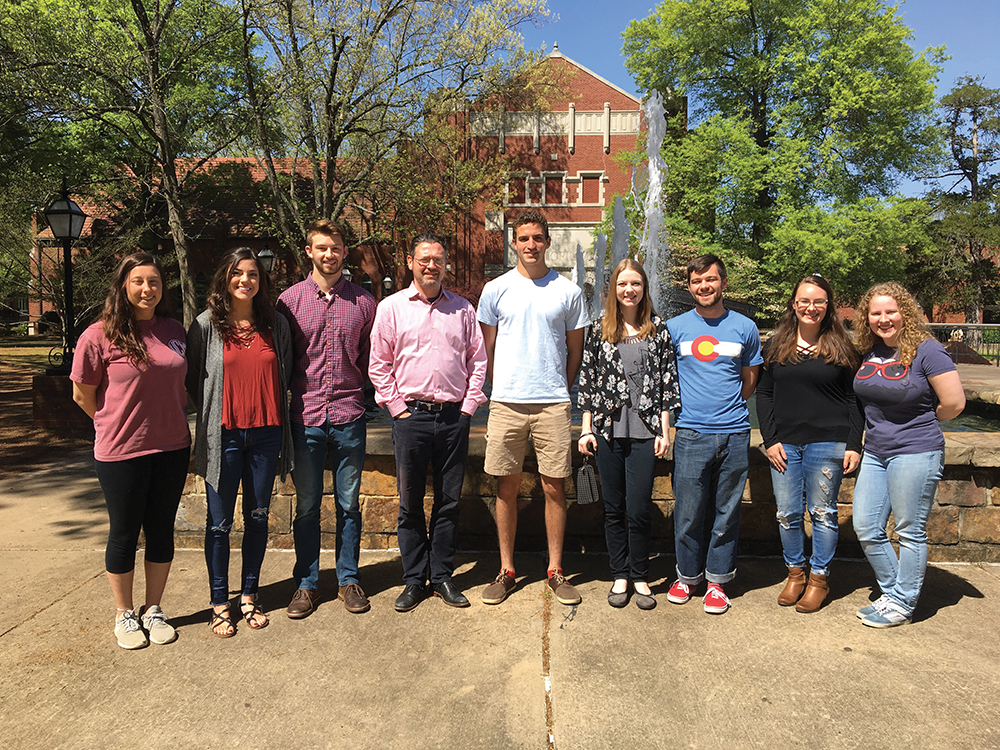Study
in yeast investigates roles of DNA sequences in fundamental cellular processes

Students who worked in Dr. Andrea Duina’s lab pose in front of the Hendrix
fountain. Those with * next to their names are listed as authors on the paper
published in BMC
Research Notes. From left: Sydney Ozersky ’17*, Heather Prowse ’18*, Daniel
Habenicht ’18*, Dr. Andrea Duina*, Sam Byrd ’19*, Jessica Campbell ’19, Graham
Harris ’18, Brianna Hoyt ’19*, Michaela Edwards ’19.
CONWAY, Ark. (August 29, 2024) — A new article published
in the journal BMC Research Notes features the work of Hendrix College Professor
of Biology Dr. Andrea Duina and a dedicated group of Hendrix students who
worked on research with his guidance.
“Assessing contributions of DNA sequences at the 3’ end
of a yeast gene on a yFACT RNA Polymerase II, and nucleosome occupancy” was
published on August 6, 2024, and is the culmination of research beginning in
2016.
“This paper has been a long time coming and is the fruit
of a lot of work and persistence by all the authors involved,” said Duina. “I
am particularly proud of the student researchers who carried out a large
portion of the studies — not only did they perform great work, but they also
acquired a variety of important skills along the way, such as how to implement
the scientific method and how to effectively communicate complex scientific
concepts, that will be useful to them as they progress through their careers.”
Research for the paper was funded by the National Science
Foundation and was done exclusively in Dr. Duina’s lab at Hendrix. The student
authors are Sam Byrd ’19, Brianna Hoyt ’19, Alex Crocker ’16, Daniel Habenicht
’18, Mattie Nester ’20, Heather Prowse ’18, Claire Turkal ’18, and Lauren
Joseph ’20, and the lab technician author is Sydney Ozersky ’17.
The study investigated whether DNA stretches present at
the end of a specific gene influence how certain protein complexes physically
interact with the gene. Duina and his students found that one of the DNA
stretches tested does indeed show such an activity. This work was performed
using the budding yeast Saccharomyces
cerevisiae as a model system. Given the high degree of conservation between
yeast and human cells, the research can provide insights into human biology as
well.
“I am very grateful to the National Science Foundation
for having provided the funding to make this work possible and for continuing
to support the current research taking place in my lab,” Duina said.
The article is available here.
About Hendrix College
Founded in
1876, Hendrix College is featured in Colleges That Change Lives: 40 Schools
That Will Change the Way You Think About Colleges and celebrated among the
country’s leading liberal arts colleges for academic quality, engaged learning
opportunities and career preparation, vibrant campus life, and value. The
Hendrix College Warriors compete in 21 NCAA Division III sports. Hendrix has
been affiliated with the United Methodist Church since 1884. Learn more at www.hendrix.edu.
“… Through
engagement that links the classroom with the world, and a commitment to
diversity, inclusion, justice, and sustainable living, the Hendrix community
inspires students to lead lives of accomplishment, integrity, service, and
joy.”
—Hendrix College Statement of Purpose